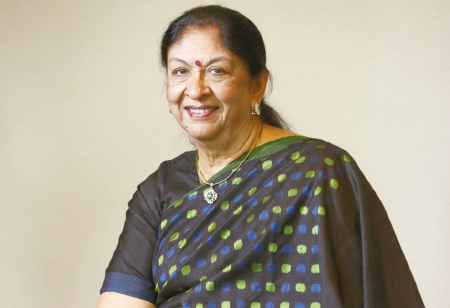
A recipient of many prestigious accolades, Radha holds the distinction of being awarded as the Outstanding Woman Entrepreneur for nine consecutive years
An astounding but not very well known fact about Indian aviation is that we have the highest ratio of women pilots in the world. According to the statistics released by International Society of Women Airline Pilots, India has 1,092 women pilots out of a total of 8,797 pilots – which amounts to 12.4%, against a worldwide average of 5.4%.* This is no mean achievement in a society like ours where women are still struggling for equality in many workspaces which are traditionally considered male dominated. These numbers can be higher only if the girls have strong support from their families when choosing education options that are expensive. Significantly, this lead in civil aviation is slowly being replicated in the Air Force as well. Women officers have been piloting helicopters in the Air Force for many years, and only recently three of them became pioneers as pilots of fighter aircraft as well.
But is this enough? Can we rest on the laurels of these figures and believe that as an industry, aviation has a reasonably good representation of women? Sadly, the answer is no. Pilots and cabin crew are only a small percentage of the total workforce within the industry. While inarguably they are the most visible to the passengers (apart from the executives at the check in and boarding counters), it takes a staggering number of others to make every flight happen. From the engineers readying each aircraft to fly and certifying them as fit to do so, the specialists manning Air Traffic Control from the loft towers looming above airports, to the yellow jacketed personnel marshaling the aircraft as they land and taxi there are a host of members in this well oiled team that makes your flights possible. It is not surprising that representation of women amongst these behind the scene workers is abysmally low.
Reasons for this are not difficult to fathom. While awkward and irregular working hours are the most obvious and in your face reason, it is not the only one. Majority of these jobs require a background in Science subjects at high school level – commonly referred to as STEM (Science Technology Engineering and Math). Traditionally, girl students in schools, with the exception of those wanting to pursue a career in medicine or engineering, tend to opt for humanities stream. One reason for this is the lack of awareness about career options besides medicine and engineering that are available to STEM students. In the aviation jobs mentioned earlier for instance. With the boom in aviation that everyone is talking about (and we are witnessing around us) – particularly in India with the UDAN scheme aimed at bringing tier 2 / tier 3 cities on the aviation map – the sector would be one of the major providers of employment in the years to come. It is imperative that women not be left out of availing opportunities in this sector purely because of lack of awareness.
Efficiencies is logistics and supply chain industry is vital not just for incumbents and customers but for overall global progression as well
Having realized this as a live issue, a group of us women from different areas of the aviation industry have come together to form the Indian Chapter of Women in Aviation International. The organization is doing its bit to raise awareness about job opportunities in aviation and the necessity of opting for STEM subjects at high school level to avail of these. Comprising of a group of passionate women, all volunteers, working in various roles in the aviation industry, Women in Aviation speaks to girls from schools in various parts of the country during specially organized events. The girls are given an insight into the plethora of job roles and opportunities, and wherever feasible, they are also taken to the local airports to give them a first hand glimpse of the working environment. Till date the India Chapter has touch the lives of 2000+ girls across India.
This small initiative is but a drop in the ocean towards encouraging more women to avail the massive job opportunities provided by the aviation sector. A proactive approach by HR of all the components of the aviation industry is required to bring the same level of primacy that India has in the proportionate representation of women as pilots in other aviation jobs as well.
We use cookies to ensure you get the best experience on our website. Read more...